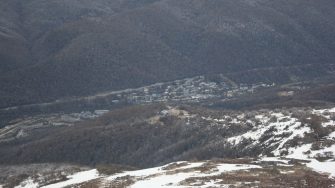
Date: Wednesday, October 26, 2016
Project: Eastern Australian Waterbird Survey
Observer: Richard Kingsford
We got away just before daybreak. It was smooth to begin with as we surveyed the King and then the Ovens Rivers, south of Wangaratta. The small floodplains of these rivers had many full lagoons but we didn’t see a single waterbird.
Surveying the Ovens River (excuse the insect smudge)
We had climb from each of the valleys of the Ovens, Kiewa and Mitta Mitta Rivers over the mountains which towered over them. Up high the wind was strong again, whipping up over the peaks and bouncing us around. The last of the rivers was the Mitta Mitta River which we flew up and over one of the major regulatory structures on the River Murray – Dartmouth Dam. The dam is immense, covering 64km2, but unproductive biologically for waterbirds – not one.
Flying down the Mitta Mitta River and over the wall of Dartmouth Dam
Dartmouth Dam stretches across different parts of the high country of the Mitta Mitta River and its tributaries
From here, we climb over the Snowy Mountains which only a few days ago got a dusting of snow.
Snow on the mountains
Looking down on Thredbo village from the top of the mountain
Once over the mountains, we descended on Jindabyne Dam, one of the great dams of the Snowy Mountains Hydroelectricity Scheme. It captures water from the Snowy River catchment diverting it over the Great Dividing Range to drive the turbines which generate hydroelectricity and also supply irrigation water on the Murray and Murrumbidgee Rivers. It is ecologically unproductive. There was environmental water currently released from the dam to go down the Snowy River.
Water gushing from Jindabyne Dam to flow down the Snowy River
From here, we headed across the Monaro plains, near Cooma, which a highlight when there is lots of water around. The stunning little natural lakes dot the landscape in every direction. The flying was hard because they came thick and fast as we flew over them – hardly a chance to catch our breath before we were on to the next one. The waterbird community was pretty thin – just a few shelducks and swans, a lot of them on nests or with broods.
Surveying small lakes on the Monaro plain
We then surveyed a couple of dams, including Brogo Dam on the Bega River which was surprisingly not full before landing for to refuel at Merimbula. Once done, we had to mop up the end of survey band 3, near Crookwell, which the survey team from last week wasn’t able to finish off because the cloud cover was so low. First up the coast for about 50km to avoid flying into Canberra airspace. On the way, we were treated to a wonderful sight of two humpback females and the calves ‘frolicking’ in the water.
Lake George, about half full, with its windfarms.
The dams near Crookwell had very few waterbirds on them, apart from the odd coot, wood duck, swan or sometimes cormorants. Again – no surprises.
Once done, we headed across to Moss Vale, finishing off by surveying the Wingecarribee Reservoir and swamp.
Wingecarribee Reservoir
Next week, we move into a series of weeks surveying all of the major wetlands in the Murray-Darling Basin for the Murray-Darling Basin Authority, starting with surveys down the River Murray on Tuesday.
